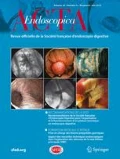Résumé
La classification des aspects des puits glandulaires correspond en endoscopie à la surface superficielle visible (aspect de puits) de la muqueuse colique et des polypes du côlon. Les détails observés ne deviennent visibles qu’après combinaison de la chromoendoscopie à l’indigo carmin (ou au violet de Crésyl) et d’une vidéoendoscopie à haute résolution. La méthode est actuellement couramment validée par des études contrôlées et semble correspondre assez bien aux données de l’histologie des lésions coliques correspondantes. Les aspects du puits I et II s’observent sur la muqueuse colique non néoplasique, c’est-à-dire la muqueuse normale (type puits I), ou inflammatoire ou encore les polypes hyperplasiques. Les aspects puits III L et IV s’observent d’habitude au niveau des adénomes tubulaires ou tubulovilleux. Les aspects III S et V s’observent fréquemment sur les adénomes plats ou les cancers coliques de type «déprimés» ainsi que sur les cancer colorectaux polypoïdes. Dès lors il existe une possibilité d’identification sélective de certaines lésions coliques avant de disposer de preuve histologique. Des lésions apparemment non visibles en coloscopie (c’est-à-dire adénome plat) sont devenues repérables grâce à cette méthode ce qui contribue à un diagnostic et une prise en charge précoces. Cette méthode doit encore prouver son rapport coût/bénéfice, ses avantages et sa commodité.
Summary
The pit pattern classification represents a description of the endoscopically visible fine surface structure (pit pattern) of colonic mucosa and colon polyps. The detailed structure is visible only after combined use of chromoendoscopy with Indigo carmine (or cresyl violet) and high-resolution videoendoscopy. The method is currently being validated in controlled studies, but seems to correlate quite well with the histology of the respective colonic lesions. Pit pattern I and II are found in non-neoplastic colonic mucosa, e.g. with normal mucosa (Pit pattern I) as well as inflammatory or hyperplastic polyps. Pit pattern III L and IV are seen with the usual tubular or tubulovillous adenomas. Pit pattern III S and V are found frequently in flat adenomas and the “depressed type” colon cancer as well as in polypoid colorectal cancers. Therefore there are possibilities for a purely endoscopic differentiation of some colonic lesions without necessity of histologic proof. Previously not visible colonic lesions (e.g. flat adenomas) become apparent with this method and may improve early diagnosis and management. This method may prove to be cost efficient, expeditious and convenient.
Références
KUDO S., TAMURA S., NAKAJIMA T.et al. — Diagnosis of colorectal tumorous lesions by magnifying endoscopy.Gastrointest. Endosc., 1996,44, 8–14.
HAYASHI S., AJIOKA Y., SUZUKI Y. — Magnifying Endoscopic Findings Correlate with Histological Findings of Colorectal Carcinoma.Endoscopy, 1999,31 (Suppl 1), E50, P0444E (Abstract).
TABUCHI M., SUEOKA N., KATO Y. — A new classification of shapes of gland outlet using high resolution colonoscope made a perfectly correct diagnosis of diminutive colorectal neoplasms.Endoscopy, 1999,31 (Suppl 1), E52, P0455E (Abstract).
TANAKA S., HARUMA K., HIROTA Y.et al. — Clinical significance of detailed observation for colorectal neoplasia using the high-resolution or magnifying videocolonoscope.Endoscopy, 1999,31 (Suppl 1), E52, P0456E (Abstract).
Author information
Authors and Affiliations
About this article
Cite this article
Hahn, M. Classification des pults glandulaires selon leur aspect. Acta Endosc 31, 189–194 (2001). https://doi.org/10.1007/BF03023608
Issue Date:
DOI: https://doi.org/10.1007/BF03023608
Mots-clés
- adénome
- adénome tubulaire
- adénome villeux
- cancer colorectal
- cancer superficiel de type déprimé
- classification selon l’aspect des puits glandulaires
- chromoendoscopie
- dysplasie
- endoscopie à haute résolution
- endoscopie à optique grossissante
- polype colique

